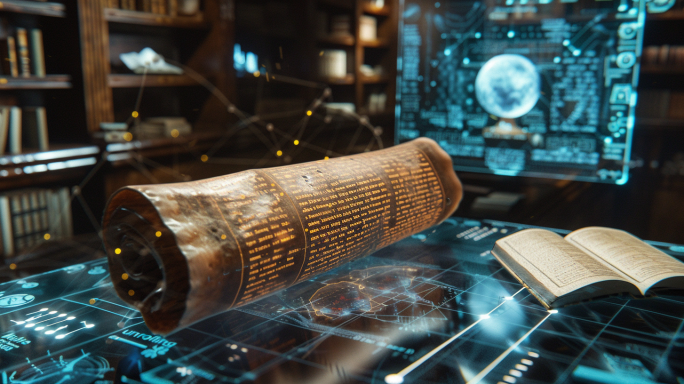Introduction
In an extraordinary fusion of ancient history and modern technology, researchers have successfully decoded an ancient scroll too damaged to be read by traditional methods. Using advanced AI technology, this remarkable breakthrough has allowed scholars to virtually “unroll” the fragile document, revealing its hidden text. The scroll, believed to date back to the Herculaneum library, provides new insights into the literature and knowledge of ancient civilizations. This pioneering approach opens new doors to understanding our past.
The Discovery of the Scroll
The Herculaneum Library
The scroll in question is believed to originate from the Herculaneum library, buried under volcanic ash during the eruption of Mount Vesuvius in 79 AD. This library, located in the ancient Roman town of Herculaneum, was home to countless works of literature and knowledge, many of which were thought to be lost forever.
Initial Condition of the Scroll
When discovered, the scroll was in a fragile and charred state, making it impossible to read without causing further damage. Traditional methods of unrolling and deciphering were out of the question, leaving the scroll’s secrets hidden for centuries.
The Role of AI in Decoding
Introduction to Advanced AI Technology
Recent advancements in AI have provided new tools for researchers, particularly in the field of computer vision and machine learning. These technologies can analyze and interpret data in ways previously unimaginable, making them ideal for tackling complex problems like decoding damaged manuscripts.
The Process of Virtual Unrolling
Using AI, researchers developed a method to virtually “unroll” the scroll. This process involves creating a digital 3D model of the scroll and then using algorithms to simulate the unrolling process. This allows the text to be revealed without physically manipulating the delicate document.
What the Scroll Revealed
Content of the Scroll
The text revealed on the scroll has provided invaluable insights into the literature and knowledge of ancient civilizations. It contains philosophical discussions, literary works, and potentially even scientific treatises that were previously unknown to modern scholars.
Historical and Cultural Significance
The contents of the scroll shed light on the intellectual pursuits of the time, highlighting the depth and breadth of knowledge possessed by ancient scholars. This discovery has the potential to reshape our understanding of ancient Roman and Greek literature and philosophy.
Implications for Future Research
New Methods for Ancient Manuscripts
The success of this AI-driven approach has significant implications for future research. Many other ancient manuscripts are in similar conditions, and this technology can be applied to unlock their secrets without causing further damage.
Broader Applications of AI in Archaeology
Beyond manuscripts, the techniques developed for this project could be applied to other areas of archaeology. AI can assist in the analysis of artifacts, reconstruction of ancient sites, and even the translation of ancient languages, providing a new dimension to the field of archaeology.
The Collaboration Between Technology and History
Interdisciplinary Efforts
This project exemplifies the power of interdisciplinary collaboration. By bringing together historians, archaeologists, computer scientists, and engineers, the team was able to achieve something that none could have accomplished alone.
The Future of Historical Research
As technology continues to advance, the potential for new discoveries in historical research is immense. AI and other emerging technologies will undoubtedly play a crucial role in uncovering and understanding the secrets of our past.
Conclusion
The decoding of the ancient scroll using AI technology marks a monumental achievement in the field of historical research. This breakthrough not only reveals new insights into the literature and knowledge of ancient civilizations but also sets a precedent for the use of advanced technology in the study of history. As we continue to develop and refine these methods, the past will become more accessible and understandable, providing a richer and more nuanced view of our shared heritage.
FAQs
1. What is the significance of the Herculaneum library?
The Herculaneum library was an ancient Roman library buried during the eruption of Mount Vesuvius. It housed numerous works of literature and knowledge, many of which were thought to be lost.
2. How does AI help in decoding ancient scrolls?
AI technology allows researchers to create digital 3D models of scrolls and simulate the unrolling process, revealing the text without physically manipulating the fragile documents.
3. What types of content were found on the decoded scroll?
The scroll contained philosophical discussions, literary works, and potentially scientific treatises, providing new insights into ancient literature and knowledge.
4. Can this AI technology be used on other ancient manuscripts?
Yes, the success of this method means it can be applied to other damaged or fragile manuscripts, potentially unlocking many more historical secrets.
5. What are the broader implications of using AI in archaeology?
AI can assist in analyzing artifacts, reconstructing ancient sites, and translating ancient languages, greatly enhancing the field of archaeology and our understanding of history.

